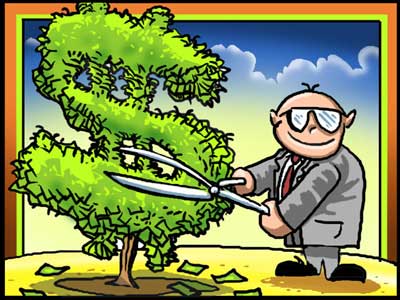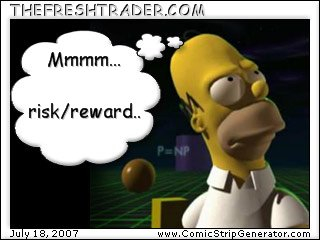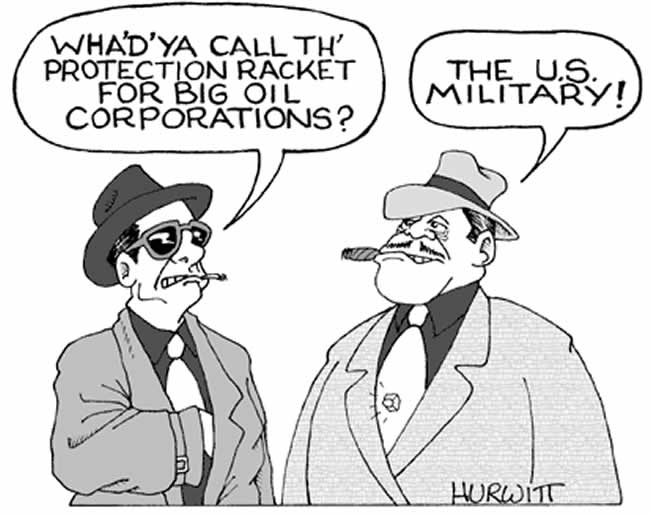 It's been a long time since we were worried about a steep drop.
It's been a long time since we were worried about a steep drop.
We have some very successful hedges already as I've been pounding the table on TZA since $13.50 and, since you know I am a big fan of taking cash off the table in either direction, let's not be greedy and look at ways to "roll" our existing downside protection into new downside plays so we can set SENSIBLE stops on our now deep in the money short plays (very similar to our Mattress Strategy).
Keep in mind that Friday was the biggest market decline we've had since May, so adding a layer of protection here doubles our returns if this is the first leg of a major sell-off, or it gives us a smaller hedge that we can roll up later while we take our bigger hedges off the table. As I have to say WAY too often to Members – It's not a profit until you cash it in!
Hedging for disaster is a concept I advocated during another "recovery," in October of 2008, where we made our cover plays to carry us through a worrisome holiday season and into Q1 earnings – "just in case." That "just in case" saved a lot of portfolios! The idea is to take disaster hedges using high-return ETFs that will give you 3-5x returns in a major downturn. That way, 10% allocated of your virtual portfolio to protection can turn into 30-50% on a dip, giving you some much-needed cash right when there is a good buying opportunity. At the time, I advocated SKF Jan $100s at $19. SKF hit $300 around Thanksgiving and those calls made a profit of over $280 (1,400%), so putting even just 5% of your virtual portfolio into that financial hedge would give you back 75% of your portfolio when you cash out.
Keep in mind these are INSURANCE plays – you expect to LOSE, not win but, if you need to ride out a lot of bullish positions through an uncertain period, this is a pretty good way to go. I have long wanted top put up a Buy List but it's still too risky as the Dow has been unable to break our 13,600 target and the S&P has failed to hold 1,440 and, as I warned just yesterday morning, ahead of a 200-point drop, the Dow has no real support all the way to 13,295. As it turned out, we bottomed out at 13,312 and finished at 13,343.

At this point, we are very likely in the capitulation/depression area of the curve BUT it is possible that we're only in FEAR and things are worse than we think. I am HOPING (not a valid investing strategy), that Friday's high-volume sell-off was more capitulation by those who didn't realize Q3 earnings were going to be bad than the onset of fear as investors simply didn't understand how bad Q3 was. Of course it was bad – why do you think the Fed moved to save the economy? I haven't given up yet but we do need to be prepared for a larger breakdown – hence these trade ideas.
On the whole, we haven't been very bullish since the end of July, when the S&P topped out at 1,400. We've kept our main, virtual Income Portfolio lightly invested as we keep expecting a drop and we haven't sold ANY short-term puts – specifically out of fear of being burned like this. It's fine to speculate with our smaller portfolios but not with our main Income Producer. One speculative play I did like on the release of QE3 was on gold on 9/23 – it's even cheaper now and makes a good long-term inflation hedge:
I'm not a big fan of gold (and we have some GLL short plays on it here) but, long-term, if it runs, it can be lucrative and, rather than buying 10 ounces of gold for $17,750, you can buy 10 GLD June $145/170 bull call spread for $16.70 ($16,700) and all GLD has to do is hold $170 (now $171.50) and you make $8,300 or about 50%. Buying physical gold, it would have to move to $2,600 an ounce for you to get the same bang for your bullion bucks. Break-even on that trade is $161.70 so it has built-in protection as well.
Despite gold dropping $35 since I wrote up these trades, the GLD spread is still $16, so very little damage done there. We also had a more complicated trade on silver that was anchored with the sale of 2015 puts on ABX, which has also dropped and now the 2015 $33 puts are $5.60 (were $5) and make for a great offset as long as you REALLY want to own ABX for net $27.40, which is 29% below the current price of $38.78. As to the short-term GLL (ultra-short gold) hedge – we cashed those and, unless $1,720 fails to hold (the 50 dma), we don't think we'll need more.
 I would urge you to read the original Disaster Hedge post in our Virtual Portfolio Section, to get an idea of our mindset at the time, where I said:
I would urge you to read the original Disaster Hedge post in our Virtual Portfolio Section, to get an idea of our mindset at the time, where I said:
As far as hedging goes, if you are 50% invested and 50% in cash and you are worried about losing 20% on the stock side in a major sell-off, then the logic of these hedges is to take 40% of your cash (20% of your total) and put it on something that may double while the other positions lose. If things go down, your gains on the hedge offset some of the losses on your longer positions. If things go up, you can stop out with a 25% loss, which will "only" be a 5% hit on your total portfolio but it means we are breaking through resistance and your upside bets are safe and doing well. That is not a bad trade-off for insurance in this crazy market. Also, be aware that these are thinly traded contracts with wide bid/ask spreads and you need to use caution establishing and exiting positions.
As we are now, we were very keyed on watching the top of the summer's range for support, which were at the time: Dow at 13,300, S&P 1,420, Nasdaq at 3,075 (blown thanks to AAPL), NYSE 8,100 and Russell 820. These are all levels that give up all of September's gain but things can get far worse if we have another crisis of confidence, as we did in 2008-2009. It's still too early to bargain hunt because that was a mistake we made in 2008 – looking for floors that never came – so we need to be judicious in our bottom-fishing expeditions.
Keep in mind that these are 2nd stage hedges as we already have TZA hedges from higher levels (Russell 840-880, now 828) we have a Fed meeting next week and Fed speak could turn the market right back up but, we do need something, in case it doesn't. That being the case, here’s a few ideas to help ride out a larger downturn as well as to protect our eventual buys:
- DXD Jan $49 calls at $2, selling Jan $55 calls for $1.15. This is a net .85 entry on a $6 spread so your upside is 605% at $55 (DXD is now $47.25). If the Dow ends up holding 13,200 and moves back up, there’s a good chance you can kill this cover with a small loss as a $5 move on DXD is about 10% and that would be about a 5% move up in the Dow to 14,000 before the Jan $49s lose half their value (which is still more than you paid for the total spread). You need $49.85 (+5%) to get your money back and that's a 2.5% drop in the Dow to 13,000, so you are well-protected for any dip below that line.
- TZA is still our favorite hedge and you can pick up the April $14/22 bull call spread for $2 and you can sell the April $13 puts for $1.35 for net .65 on the $8 spread, giving you 1,130% of upside potential and, best of all, with TZA at $15.60, you are starting out 246% in the money! TZA drops $2.60, to $13 if the Russell goes up 6% plus these ultra-ETFs tend to decay over time but owning TZA for net $13.65 is not a bad portfolio hedge and the Russell would have to be net up in April for this to happen and, if so, your longs should be doing well.
When you are entering a trade like this, assume you will have TZA put to you at $13.65 and allocate how much you are REALLY willing to own. Say that’s $13,650, which would be 1,000 shares and that means you can make this trade with 10 contracts at a net cost of $650 plus (according to TOS) $4,500 in margin. This play returns $2,600 if TZA simply stays flat and holds $15.60 through the April expiration. This hedge then, protects $50,000 worth of existing positions against a 15% loss for $650 (hopefully, you already have buy/writes that protect you from a 20% drop, so we're good for 35% total downside) – plus some margin you'd better have laying around anyway!
- SDS Jan $56 calls at $3, selling Jan $62 calls for $1.65 and selling HPQ Jan $14 puts for .87. Here we are in a $6 spread for net .88 with the possibility of making $5.12 (581%) if SDS hits $62 (up $7.16 or 13% or down 7% on the S&P to 1,332). We may have HPQ put to us for net $14.87 at that level (now $14.48). Of course, we can roll the puts down to the 2014 $10s (now .90) – which is a pretty good entry on HPQ (30% off)! Remember, the premise is that it's not likely to have HPQ go below $14, let alone $10 if the S&P is rising so your expected cost of insurance is that .87 – although you can stop the bull call spread out long before that happens. If you are willing to own $15,000 worth of HPQ at around $10 in 2014, it's reasonable to take 15 of these hedges, which return $9,000 if the S&P falls 7%. The margin on 15 short HPQ Jan $15 puts is just $1,500 according to TOS – so not tragic if forced into the long-term short puts.
 Another nice thing about this trade, in a vacuum, is that – IF we have a catastrophic failure that forces you to buy 1,500 shares of HPQ for $10 – there's a pretty good chance you will have collected that $9,000 from the SDS spread and that means you are buying 1,500 shares of HPQ for net $6,000 – just $4 per share!
Another nice thing about this trade, in a vacuum, is that – IF we have a catastrophic failure that forces you to buy 1,500 shares of HPQ for $10 – there's a pretty good chance you will have collected that $9,000 from the SDS spread and that means you are buying 1,500 shares of HPQ for net $6,000 – just $4 per share!
Another way to hedge SDS if you are not margin constrained is by selling SPY puts. SPY Jan $125 puts are .92 so a net of .73 on the above spread and you KNOW the puts are rollable and, of course, the SPY puts CAN'T go in the money until AFTER you make $5.27 per spread. What you are playing for here is that the S&P will drop 7% but not 12.5% (and, assuming a roll, 20%).
I'm sure some of our more savvy traders have already realized that once SPY drops 10%, we can simply add more hedges and at 15%, more hedges and at 20%, even more hedges to protect against getting too burned on the short puts. Layering in our Disaster Hedges is always a good plan. After all, that's what these hedges are as we've already got plenty of hedges like this from when the market was 15% higher!
The great thing about this kind of play is that, if the S&P goes up, the insurance is half price as the short puts expire worthless. You can even stop out the $1.65 hedge at around $1 and you end up with something in your pocket as a reward for all your hard work.
 Keep in mind that this is insurance, not betting. These are hedges that are meant to perform for you if your upside bets don't work out and will hopefully not cost you too much money when your upside plays go well. If your upside plays are sensibly hedged, like our buy/writes that pay at least 10% a quarter in a flat to up market, then this kind of sensible insurance is all you should need to offset reasonable dips in the market. It doesn't mean you don't need stops.
Keep in mind that this is insurance, not betting. These are hedges that are meant to perform for you if your upside bets don't work out and will hopefully not cost you too much money when your upside plays go well. If your upside plays are sensibly hedged, like our buy/writes that pay at least 10% a quarter in a flat to up market, then this kind of sensible insurance is all you should need to offset reasonable dips in the market. It doesn't mean you don't need stops.
- EDZ is my other universal hedge. It's a 3x inverse to the MSCI Emerging Markets Index which is BRIC-weighted but also includes Africa, Eastern Europe, the Middle East and Latin America so our bet is that something goes wrong somewhere in the world sometime. With EDZ now at $11.52, the Jan $12/16 bull call spread is just .60 with a $3.40 upside potential (566%). You can reduce the net further by selling the Jan $9 puts for .35, dropping the spread to just .25 and increasing your potential gain on cash to 1,500%. This is a very nice way to play against a breakdown in emerging markets.
- Finally, let's look at a stock play. V has been a white whale for us, going up and up no matter how much we short them but, at $140 – they HAVE to be tired. Earnings are on the 30th and they are expected to earn a solid $1.49 but, looking at tech and other sectors – it just doesn't seem like that much money is being spent. AXP had in-line earnings and is down 5% since then and you can pick up the V Nov $135/130 bear puts spread for .85 and that makes up to $4.15 (488%) if V drops $10 (7%) but, we're looking for 500% trade ideas so how about selling an AXP April $45 (now $56.86) put for .66 and that knocks the spread down to .23 with a potential 2,073% upside.
 As with all of our protection plays, if we become more confident that the market will NOT collapse, then we simply take them off the table with a small loss and that makes us more bullish but having a few hedges like this in your portfolio can do a lot to cushion the blows from any major market sell-offs.
As with all of our protection plays, if we become more confident that the market will NOT collapse, then we simply take them off the table with a small loss and that makes us more bullish but having a few hedges like this in your portfolio can do a lot to cushion the blows from any major market sell-offs.
I cannot remind you enough though that these are insurance plays and they are not ideal for rolling or adjusting and you should EXPECT to lose money if the market heads higher – much the same as you expect to have "wasted" your life insurance premium for the prior year every time you celebrate another birthday….
As with life insurance, it may make you feel good to walk around with $50M worth of protection in case you get hit by a bus but – is it realistic? Look at your portfolio and think about what kind of protection you REALLY need. If you have $100,000 worth of May buy/writes that are good for a roughly 15% dip in the market, then you don't really need ANY protection against a 15% drop. If the market drops 25%, then you will lose 10% on what you have now. If the market drops 40%, then you lose 25%. We all learned how valuable it can be to simply stay even in a major market drop as opportunities abound then so simply putting 5% away on hedges that will pay 25% back when the market drops 40% will let you cash out with 100% of what you have now and go shopping – that's all insurance needs to do!
Disaster hedges are a good exercise in managing your portfolio but, unfortunately, like Auto insurance, you just pay and pay and pay until you have that accident. So safe driving!




